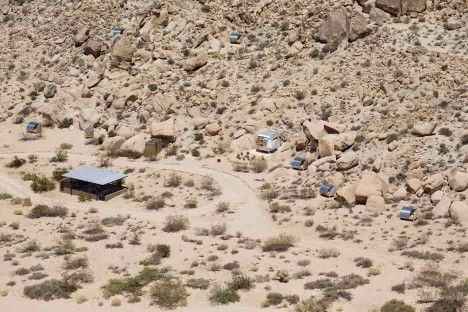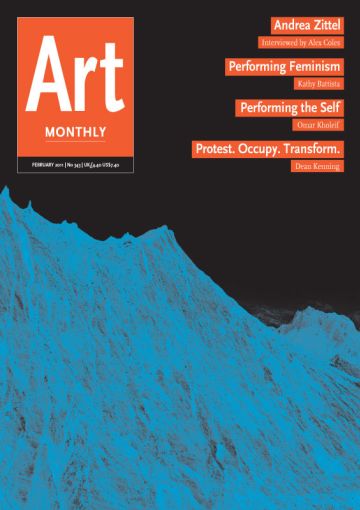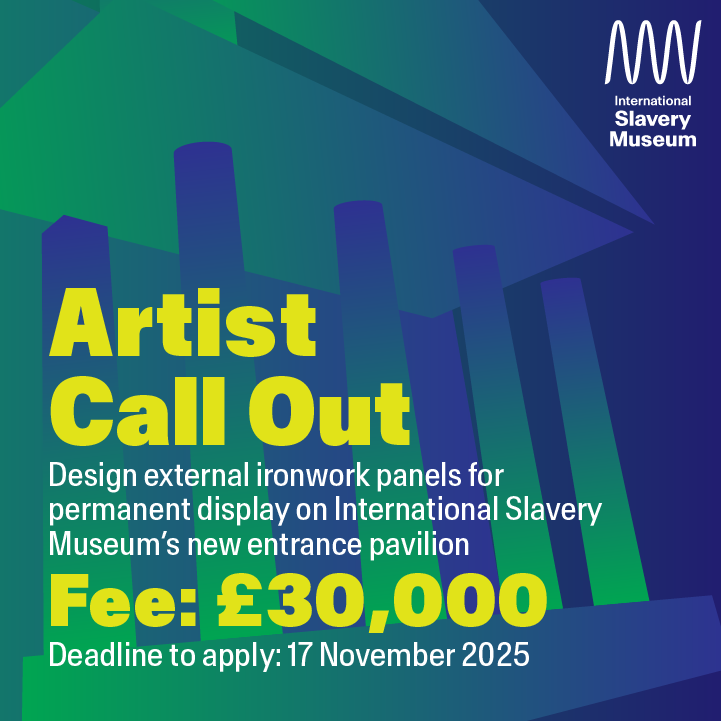Interview
A-Z
Andrea Zittel interviewed by Alex Coles

Andrea Zittel, ‘AZ West’, 2015
Alex Coles: I know that at A-Z West – 35 acres of land in the Californian high desert next to Joshua Tree National Park – you have a number of shipping containers currently being used in lieu of a studio. How did that evolve?
Andrea Zittel: Those containers are really a pain in the ass! They get superhot in the summer and very cold in the winter. We can never fit a full eight- hour workday in. The containers have really been more of a stepping stone towards building a larger space out here. The new studio will have 4,000sqft of interior space, which will allow me to work in advance of exhibitions – it will be great to be able to edit installations before actually installing them in galleries.
Having said that, I also have to admit to feeling more grounded when working in my home – you can always turn a room in a house into a studio for a few days and then flip it back afterwards. There is something about the studio space being a part of my habitat that I really like.
There is an obvious link between these containers and the series of works that you are perhaps most known for: the ‘A-Z Travel Trailers’. Was your decision to use them driven by a need for conceptual continuity or was it something really pragmatic?
I have always been into the modular aspect of shipping containers – they are in everyone’s backyard out here in the desert. Whenever someone has too much stuff in their house they get a shipping container and dump it all in there. They look pretty junky, but I’m often drawn to a kind of vernacular architecture that is junked up because you have to make a real effort to get it to look good.
When I first moved out here I was trying to avoid having to get permits of any kind. I didn’t want to build a building as a studio because I was in some way ideologically opposed to having to file for building permits from the Building and Safety Department. Later I found out that, technically, I was even supposed to get a permit for the containers, and since I didn’t go through this process I got in trouble anyway ....
What, do officials cruise around the desert on a regular basis checking for illegal architecture?
No, I think the guy down the road turned me in.
Tell me a little about the development of your studio and the path that led you to these containers.
From the beginning I have always had a series of what I would term ‘spaces’ rather than professional studios. In the early 1990s I had a little storefront space in Brooklyn where I lived and worked. In early 1994 I moved into a larger loft space a few miles away where I also lived and worked. At the time, this space didn’t have any running water or heat. All my work from that period – A-Z Dishless Dining Table and Prototype for A-Z Cleansing Chamber, both of 1993 – addressed the physical needs of the body. Later in 1994 I moved into A-Z East, a little storefront in Brooklyn, which soon became an exhibition space and testing ground for my work. When we built things in Brooklyn we often had to use the sidewalk in front of the building because there wasn’t enough space inside. Following this, I had a short stint living in a suburb in Los Angeles where I worked in a trailer in the front yard, and from there developed A-Z West in the desert in 2000 – a further exhibition space and testing ground but with a lot of outdoor space. This is where the shipping containers come in.
How is the space you have at A-Z West playing out in terms of the production of the work for the show in Berlin? Is it because of the demands of the Sprüth Magers space that you are feeling the limitations of the containers so acutely at the moment?
Yes, though I have been feeling this way for a while. For the Sprüth Magers show we are making a large series of interconnected wall sculptures that also function as shelving units. The units are too big to work on in the containers, and it is winter here right now, too, so we are working outside in rain, hail and wind. Almost all of the galleries I show in started out small but are getting bigger and bigger now and really require a lot of production in order to fill. Sometimes this can be frustrating because I don’t necessarily think I’m that kind of studio artist; however, I do like the challenge of a big space. What interests me in this relationship is how the architectural development of the gallery has directly affected the studio model of the contemporary artist. In the last ten years galleries have been getting bigger and bigger and I feel that in many cases this has really forced artists to supersize and professionalise their studio practice. Art has become more production oriented and in many cases less contemplative or philosophical.
At A-Z West do you fabricate the relatively modest sized mobile vehicles and ‘A-Z Wagon Stations’ yourself? What happens when you do something much larger in scale like Indianapolis Island of 2010?
Often I work with assistants. But sometimes I work with fabricators – this was certainly the case with the Indianapolis Island. The ‘A-Z Wagon Stations’ are now mostly fabricated here: one person welds the frames off-site and then they are powder-coated and transported here where we get all of the panels in place and trick out the interior. This kind of assembly isn’t actually that complex, it just takes time and demands space.
I didn’t realise that you did so much fabrication in-house. I remember the special issue of Artforum in October 2007 devoted to the subject of production and your article in there focused on a fabricator you worked with. I just assumed that was the case for much of your work.
In the late 1990s I started working with Callen Camper Company – a custom trailer outfit that mostly makes trailers to haul off-road vehicles that they call toyboxes. They made the large trailers for me and also the ‘A-Z Escape Vehicles’. The issue of production also depends on the budget and the deadline. Sometimes we’ll get things done outside because it is so much quicker, but this means it costs more too.
In terms of the notion of the post-studio artist, what is your take on that legacy given the way you work?
I don’t know if I consciously position myself in relation to that category. From time to time I think about it – lightly. I think I’m really stuck between the ‘post-studio’ generation of the 1990s and the mega-studio syndrome that is happening right now. What sometimes strikes me about the difference between most artists who I’m often compared with in the post-studio category is that they usually have large studios and entire production facilities. By contrast, I still work alone most of the time. Sure, I have part-time people that come in for a few days a week – they float in and out and usually are friends – but it doesn’t feel like a real industry. I just find it’s impossible to think when there are five people hanging around waiting for me to make a decision. Perhaps a large studio would be more efficient, but in my world privacy is the ultimate luxury.
Can you take me through the process by which your production model works? For instance, do you develop the sketches and prototypes before passing them down the line?
I am not very good at drawing and I certainly don’t know how to use any kind of 3D computer program – yet. I generally think about a new work for several years before deciding to move forward. Once I feel it is time to realise the project, I’ll do materials experiments in private and then teach my assistants how to help me take it full scale. Or if I work with a fabricator we will meet up several times and go through a lot of contortions – including mental telepathy – in order for me to communicate my ideas.
Another area I wanted to ask you about is the subject of ‘lifestyle’. The first time I saw your work was at the Münster Sculpture Project in 1997 when it was side-by-side with works by Atelier van Lieshout, Tobias Rehberger and Jorge Pardo (Interview AM339). The exhibition gave the impression of a generation that was using the vocabulary of design as a point of access into an investigation of lifestyle. This is especially so in your case.
Right. It’s true it all came together at once in the 1990s. In part, I think this may have been influenced by the industrially fabricated art of the 1980s – Haim Steinbach and Ashley Bickerton et al. The vocabulary and production methods of design lent their work the appearance of gaining access to the tangible real world – and that kind of access was something that my generation really jumped on. When I first became interested in design I spent a lot of time researching it and its links to fine art (Profile and Response AM181). I thought that if an art historian of the future were studying the art of the 1990s they would have to take design into account. I remember being frustrated by how most fine art hinged on trivial observations or certain topics – but that design dealt with broader issues of how life is lived within a set of wider societal conditions. At the time, this was a big part of my rationalisation for wanting to use the language of design.
The historical Avant Garde’s use of design as an instrument to organise everyday life was premised on various forms of utopian thinking. Other artists of your generation, including some of the ones in the Münster exhibition in 1997, have also been interested in this subject – leading them to create micro-utopias of their own: Atelier van Lieshout’s ‘free state’ AVL-Ville in a port in Rotterdam; Rirkrit Tiravanija’s The Land project in Thailand; and Jorge Pardo’s haciendas in the Yucatan jungle. Do you see a point of correspondence here between these projects and your High Desert Test Sites (HDTS), A-Z Pocket Property of 2000, and A-Z West in terms of scale and ambition?
Definitely. I think there are many overlaps and also, of course, many differences. For instance, the islands that I construct are meant as utopias for one person – a bitter-sweet idea. A number of my works touch on the societal construction of individualism as a way of discussing how individuals are not able to live within the construct of a collective any more. I remember being really interested in Tiravanija’s The Land and its ability to pull the art world out of its centre by creating other centres. I feel an affinity with this project since creating a centre outside of a centre has also been a long-term goal with the project at A-Z West.
This is something you are also trying to do with the HDTS, the series of experimental art sites that includes Pioneer town, Joshua Tree, 29 Palms and Wonder Valley. At what point were you in your practice when a project of this scale and breadth seemed like something that was viable?
I have always been interested in what happens when the work of art is placed in the world at large. The idea of art having a real, lived experience outside of institutions and galleries is very important to me. In the mid 1990s I remember thinking that it would be interesting if I could be part of a community that wasn’t an art-world community, and I began wondering about where that could be and how it could come about. That place is A-Z West. It’s very comfortable for me here, partly because I have been visiting the area my entire life. I felt it was a small but diverse community where I could experiment and test out ideas of contemporary art having some sort of larger social function or meaning.
How has the project evolved since you first arrived? Has it become much more structured and professionalised now – or is it just the blog and website that makes it appear so?
A-Z West started in 2000 with five acres and a cabin, and since then I have been trying to add one large project/property a year. There is a camping area, wagon stations that people can stay in, a guest-house, main house, the studio, growing areas etc. The long-term plan is to turn everything into a large interconnected organism. I don’t know if it is professionalised – but I’m definitely continually working on it as a structure. Of course, because A-Z West is also my home and personal space – and because I am by nature a private person – it isn’t really intended as a fully public interface.
HDTS, on the other hand, is a project that is more inclusive and is always open to visitors and participants. There are several large parcels of land set aside for the projects, a home base ‘headquarters’ in downtown Joshua Tree, the website, and we also have a lot of volunteers and interns and collaborators who help pull everything off. Because there is so much activity and so many different people involved, there needs to be a lot of organisation and structure – though within this framework we still try to leave some wiggle room. And we still have trouble keeping up with the email.
There are other platforms you have generated too – including the Smockshop and, of course, the Group Formerly Known as Smockshop.
Yes, I really enjoy creating these structures and then setting them in motion. Not necessarily controlling them too much once they are actually up and running, but organising them well enough in the beginning that they can take on a life of their own.
Do you still think they would work – creatively and economically – if you totally faded into the background?
That is the eventual goal. Creatively, yes, I think they would, once I have pulled the right people in who generate the right energy to keep them in motion. Economically it is more difficult. Much of the time I’m trying to come up with a solution that will sustain these platforms without the need to apply for grants. I have been avoiding non-profit status and funding because I want to see if I can create something that is fully self-sustaining in its own right. Though for now I have to admit that most of these alternative practices are funded by income that I make through my commercial practice.
It would be difficult to transfer the HDTS project effectively into a gallery or museum context.
That is why I haven’t attempted it. To extract and re-present it in the right way would be really difficult. My show in summer 2010 at Sadie Coles was me attempting to speak precisely about this, the difference between having an experience and representing an experience. I find that I am always struggling with the various ideological constraints of representation. Over the past few years I have definitely covered some ground here but it is never an easy process.
The key paradox would seem to be how to transfer the hot social dynamic of the group effectively into the tepid walls of the white cube.
Yes. The way I have broken down my practice is that, generally, I make structures that can be used in relation to lived life. I do everything I can to ensure that. When these structures are on the verge of falling apart I extract them and aid their transition to an institution that will look after them and archive their history. If an object has as long and circuitous a trajectory as some of the ‘A-Z Vehicles’, then, when you see one of them in a museum, you get a sense of something that has really passed through time and has a story to tell. But I only figured that out recently. Many of my earlier works felt too hermetically sealed because they weren’t allowed to play out a full lived life.
Of course, gallery shows are always more difficult as usually they are presenting new works that don’t have a history. I think of the things in the gallery shows as being made for export. The works in these shows tend to be a little more reflexive or philosophical in nature – reflecting on the different structures I’m playing with that are more integrated into the direct experiences of lived life.
Frequently I find problems with your gallery shows, but seldom with the museum ones. I guess there are a number of different strategies artists have used to either attempt to get around or draw attention to this paradox, like making the exhibition the site of the documentation of an activity that took place elsewhere or staging a performance in the space, turning it into a temporary workshop or social space of some kind; or, like Robert Smithson with his series of ‘Non-Sites’, drawing attention to the impossibility of the very thing you are trying to do.
That’s interesting. I think that Smithson’s approach, from Partially Buried Woodshed in 1970 at Kent State to the ‘Non- Sites’ within commercial spaces, was often dead on. I wouldn’t ever perform lived life in a gallery since that would just be contrived. But I do like the idea of a physical energy of some sort running through the space.
The Smockshop exhibitions were engaging – partly because the activity was displaced from you onto a collective, which fabricated the garments live in the gallery space. In the most literal way, this introduced the dynamic we have been speaking of, and the one I witnessed in London at Sprüth Magers was one of the best shows I have seen of yours in a commercial gallery space.
That was a really exciting project, but I have to admit that I feel uncomfortable claiming the smockers’ energy as my own. Although I’m flattered you liked the project, unfortunately I don’t think that Smockshop was really a show by me.
How has the art/life equation that so much of your practice turns on developed over the years – not just as a thematic but as a continuous series of personal experiences?
Well, I think that my work has always evolved directly out of the act of living. Many things have changed: for instance, I have a kid now – and having responsibility for another human means I can’t live full-time in some of the living experiments that I used to subject myself to. But my work has always addressed freedom – or the illusion of it – and I think I’m now coming face to face with the moment where one has to accept limitations and create structure and meaning out of life as it is.
Andrea Zittel is at Sprüth Magers, Berlin 25 February to 2 April 2011.
Alex Coles is the author of The Transdisciplinary Studio from Sternberg Press.
First published in Art Monthly 343: February 2011.










